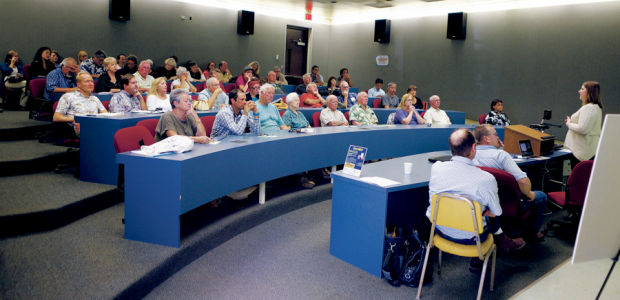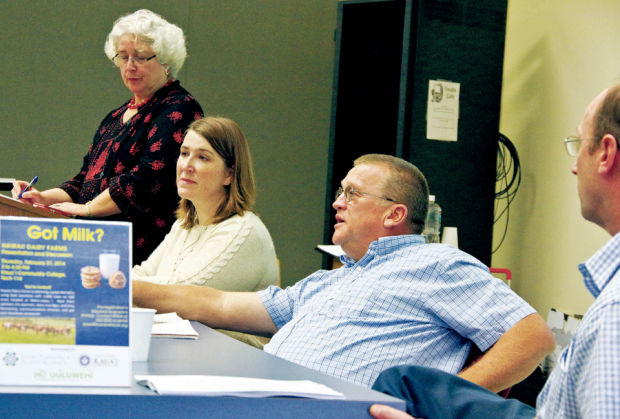PUHI — Representatives of Hawaii Dairy Farms spent Thursday evening laying out their plans for the $17.5 million, 582-acre dairy in Mahaulepu. Many community members who attended the pair of informational meetings, however, came not just to listen but to
PUHI — Representatives of Hawaii Dairy Farms spent Thursday evening laying out their plans for the $17.5 million, 582-acre dairy in Mahaulepu.
Many community members who attended the pair of informational meetings, however, came not just to listen but to voice concerns about the potentially negative impacts the business venture could have on the area.
“I think you now have an appreciation for how important and how sacred that area is for the people of this island,” Carl Berg, vice chairman of the Surfrider Foundation Kauai Chapter, told the company representatives toward the end of the meeting attended by 40 people at Kauai Community College. “There are few other places as pristine, and as so coveted to keep it pristine, as Mahaulepu.”
About 70 people attended a standing-room only meeting at the Koloa Neighborhood Center Thursday night hosted by the Koloa Community Association and Malama Mahaulepu.
At the entrance leading up to the neighborhood center on Weliweli Road, an SUV with a boogie board attached to the back window greeted meeting attendees. On the boogie board was a simple message, written in large, capitalized letters: “No Moo in Poi Poo.”
Poipu resident Jean-Marie Josselin, chef and co-owner of Josselin’s Tapas Bar and Grill at the Shops at Kukuiula, said he has lived on the island for over 30 years and is “100 percent in support of the project,” because it would help encourage local agriculture and foster food independence.
“It’s hard to find products that are made here and are from here,” Josselin said. “I know the smell is a problem for me, too — I don’t want this place to smell. But if you really look around you, there’s 2,000 to 3,000 cow already, and I drive here every day and I work here, my kids are being raised and born here, and there’s no smell. I really think it’s important that we have some industry here that produces some of the food that we live on.”
Berg and others made it clear they want to keep Mahaulepu that way, not have it polluted by the waste of the 1,800 head of cattle coming to the dairy.
Farm Manager Jim Garmatz said the project is six years in the making — one that has been “researched, re-researched and researched again” — and assured the audience that the waste from the cows would not cause problems on Kauai’s on Kauai’s Southside.
In fact, the feces and urine from those cows will only supply the farm with 70 percent of the nutrients needed to maintain the amount of grass needed on an annual basis, according to Garmatz.
As a result, the company says it will have to supplement the other 30 percent with synthetic fertilizers.
Garmatz said a loss of effluent to the water table, streams or nearby beaches would be “minimal if any at all.”
“At this point we are a non-release facility,” he said.
The grass-fed dairy will be located on a parcel of land leased from Grove Farm, about 2.5 miles inland of the Grand Hyatt Resort and Spa in Poipu. It will be modeled after the New Zealand pastoral dairy system.
Six groups of 300 to 330 cows will rotate through their own set of 18 pastures over 18 days, allowing even application of manure for proper fertilization and wastewater management, the company said.
They will be fed a diet of 70 percent kikuyu grass, supplemented by 30 percent feed and vitamins during milking.
One woman questioned whether the milk would be organic and whether the supplemental feed would consist of genetically modified seed.
“It’s not going to be organic,” Garmatz said. “We made that decision and it’s not going to be organic.”
As for GM seed, Garmatz said the company can’t control the kind of seed coming from the Mainland and that the supplemental feed will most likely contain GMOs.
Don Heacock, a fisheries biologist with the state Department of Land and Natural Resources, questioned why Hawaii Dairy Farms thinks it is guaranteed the 3 million gallons of water per day promised by Grove Farm from nearby Waita Reservoir, which gets most of its water from the Wailua and Huleia rivers.
Other questions raised Thursday include how the company settled on Mahaulepu, why it was not required to complete an Environmental Impact Statement and how the company plans to control flies in the area.
The dairy has already purchased 880 cows, which are being cared for in Missouri until the company receives the proper permits and can begin shipping them over, likely in late summer, according to company spokeswoman Amy Hennessey.
When in operation, the dairy is expected to double the statewide local milk production with 3.7 million gallons per year.
As for jobs, the company expects to create 10 to 15 full-time positions, including milkers, calf raisers, breeders, maintenance, management and herdsman.



